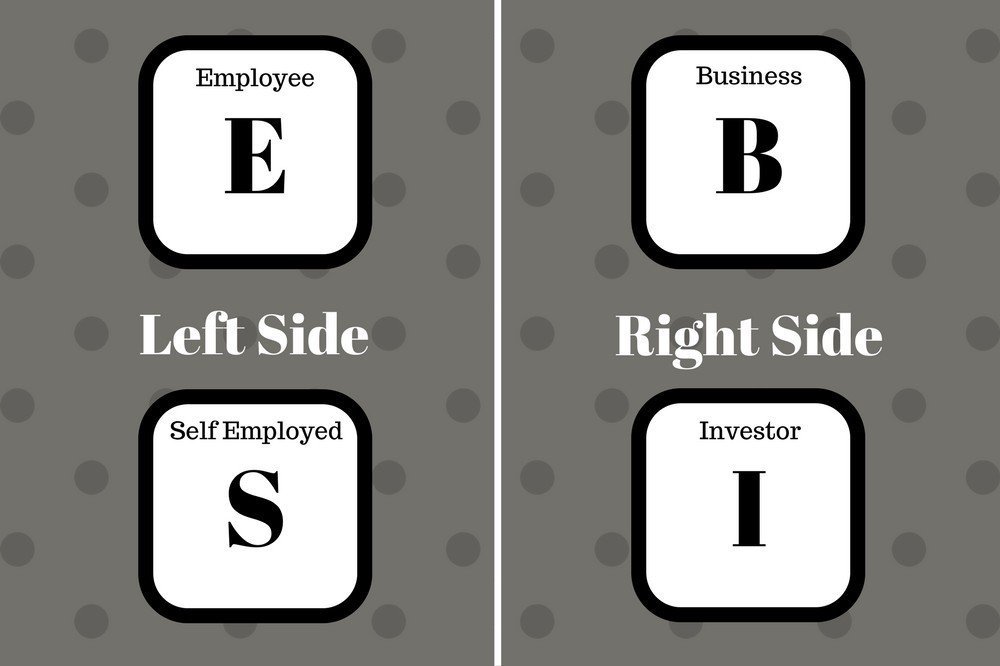Today, I was reading a book by Robert Kiyosaki and The Cashflow Quadrant caught my attention. It states that there are four ways (quadrants) to make money and it differentiates between successful people and unsuccessful people.
From my understanding, most of Robert Kiyosaki’s books contain a lot of useless information (my opinion), except for The Cash Flow Quadrant because it makes perfect sense. In this article, you will find out which quadrant you’re in and that will somewhat explain whether you are financially successful or not financially successful.
The Cashflow Quadrant Explained

In the book, “The Cashflow Quadrant is divided into four areas. However, it gets even deeper by separating the four areas into 2 sides (2 areas on each side).
Let’s go over the four areas and separate them into 2 sides:
- Employee (E) – This is pretty self-explanatory. If you work for an employer, you are considered an employee. In other words, you have a job.
- Self Employed (S) – You are working for yourself. You don’t have a boss looking over your shoulders.
Before we continue, it’s pretty obvious that E and S belong together on one side. For the purpose of this article, let’s call it the “left side“. The reason why is that they both require you and your time to make money.
- Business Owner (B) – Typically larger businesses that employ hundreds of people or more. It’s not the same as small business owners because a true business owner can run their business without their presence.
- Investor (I) – Someone who has investment income such as mutual funds, stocks, bonds, etc.
On the “right side“, you have B and I because they don’t require your presence to make money, so you are not limited to potential earnings.
Let’s explain a little more about both sides and what kind of income you’re making!
Quadrant E and S (Active Income)
On the left side, you have quadrant E and S and they both belong in the active income category. You are pretty much trading hours for dollars and the odds are against you. First of all, it requires your input in order to make money, so how many hours can you work in a day? How much money can you really make from a job?
Quadrant B and I (Passive Income)
On the right side, you have quadrant B and I, and they both belong in the passive income category. No longer will you need to be present to make money because things like your business, bonds, mutual funds, dividends will generate money for you. People on quadrant B and I don’t trade their hours for dollars because their money makes money for them. This is when you are able to make money in your sleep, while others are working their butts off to earn a living.
Recap of The Cashflow Quadrants
Most People Are In Quadrant E and S

Employee (E): Most people are in this quadrant. Basically, you’re working for a company and your income depends on you showing up to work for x-amount of hours. If you want to make more money, you must either work more hours or ask for a raise (good luck with that!).
Your employers would never pay you more than what you’re worth and you won’t make any money if you’re not available to work for your employer.
Self Employed (S): People in this quadrant receive the benefits of having more freedom, but in reality, they are still trading hours for dollars. The difference is, you don’t have someone overhead managing your everyday activity. Your income depends on the amount of work that you put in.
Very Few People Are In Quadrant B and I

Business Owner (B): When you’re a large business owner, you have a system that works for you. You have people working for you as employees on the “left side“. The benefits of being a business owner are that your business makes money so that you can enjoy the ultimate lifestyle of time, money, and location freedom.
Investor (I): This is the purest form of passive income. You don’t have to hire an employee, run a business, work a job, etc. The money you invested such as mutual funds, stocks, bonds, etc will make money for you while you do absolutely nothing. But of course, you can lose a ton of money by making a bad investment.
In Conclusion
If your desire is to have financial success, you’ll need to free yourself from quadrant E and S. You want to be on the other side with quadrant B and I.
It’s not easy because, in order to start a business, you must first have a large sum of money. Fortunately, the internet has allowed many people to start their own online business with very low upfront and upkeep cost.
I started this website with a very tight budget. As a matter of fact, it cost me on average $50.20 per month when I first started. The cost was for my recommended platform (Wealthy Affiliate) which includes a keyword research tool, a total of 10 websites including website hosting, weekly live classes, online entrepreneur certification courses, advanced affiliate training courses, classrooms, my own personal domain name, and more.
For the most part, the things I recommend are free, but Wealthy Affiliate does carry premium services that require money. As I stated previously, it costs me around $50.20 per month to get to where I am today. It’s much less than your average business model and it requires very few financial sacrifices to get it.
I’ve personally reduced my cable television bill to cover the cost of website hosting since I don’t really watch television anymore. Fortunately, through my consistency and dedication, the earnings on my website cover my online business expenses plus more.
Will you be able to get-rich-quick? Unfortunately not and I’m sorry because it’s probably not what you want to hear. However, any real business requires time and consistency to grow and to become profitable.

If you are serious about making money online and transitioning from the left side, quadrant E and S to quadrant B and I.— The opportunity is here.
Which side and which quadrant describes how you make money? Are you willing to put forth work, effort, and being consistent to achieve financial success?


 Protected by Patchstack
Protected by Patchstack